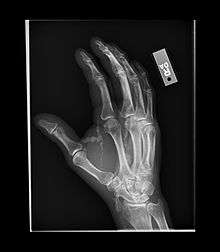Tumoral calcinosis


Tumoral calcinosis is a rare condition in which there is calcium deposition in the soft tissue in periarticular location i.e. around joints.[1] The accumulations are outside the joint capsule. They are frequently seen in patients undergoing renal dialysis. It is also considered by some to have a hereditary predisposition. The name indicates calcinosis (calcium deposition) which resembles tumor (like a new growth). They are not true neoplasms - they don't have dividing cells. They are just deposition of inorganic calcium with serum exudate. Children and adolescents (6 to 25 years) are the most commonly affected. The symptom that the accumulations cause is not pain but swelling around joints. They have propensity to enlarge progressively and ulcerate the overlying skin and extrude. They are most common around shoulders, hips and elbows. Laboratory evaluation reveal normal serum calcium levels and hyperphosphatemia. Rarely ALP (alkaline phosphatase - an enzyme active at sites of bone formation) may be elevated. Treatment is normalization of serum phosphate levels and resection of lesion. Surgical removal should be complete and if part of it is left, there is inevitable recurrence. Cutting through the excised calcium deposition reveals semifluid calcium suspension in albumin encapsulated by fibrous tissue.
References
- ↑ "Orthobullets". Retrieved 27 October 2014.